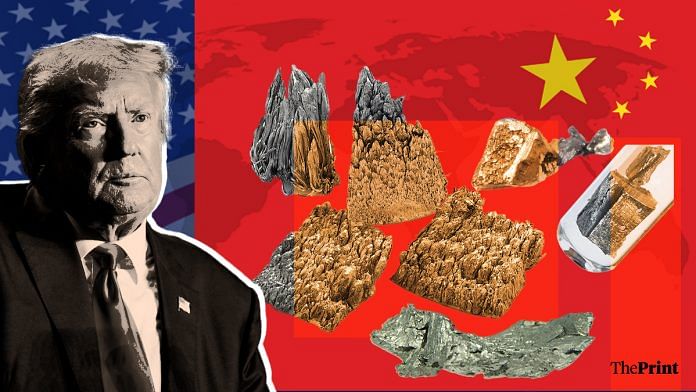Rare Earth Minerals: Fueling A New Geopolitical Cold War

Table of Contents
The Strategic Importance of Rare Earth Minerals
Rare earth elements (REEs), a group of 17 chemically similar elements, are not actually rare in the Earth's crust. However, their dispersed nature and the difficulty and cost of extraction and processing make them strategically important. These elements play a critical role in modern technology and defense applications, fueling the demand and escalating geopolitical tensions.
- Essential components in high-tech devices: REEs are indispensable in smartphones, computers, and other electronic devices, particularly in the powerful permanent magnets used in speakers, motors, and vibration sensors. Neodymium and dysprosium are especially crucial here.
- Crucial for renewable energy technologies: The green energy transition hinges on REEs. Wind turbines rely heavily on neodymium magnets for their generators, while electric vehicles utilize REEs in their motors and batteries.
- Vital for military applications: REEs are essential components in guided missiles, radar systems, and other advanced military technologies, making them a key factor in national security strategies.
- Increasing demand driven by technological advancements and green energy transition: The growing global demand, fueled by the expansion of renewable energy and technological advancements, is outpacing the supply, exacerbating existing geopolitical vulnerabilities.
- Examples of specific REE uses: Neodymium is vital for powerful permanent magnets in various applications, while dysprosium enhances the performance of these magnets at high temperatures, making it crucial for wind turbine generators and electric vehicle motors. Other REEs, such as cerium and lanthanum, find use in catalytic converters and various other industrial processes.
Uneven Global Distribution and Geopolitical Implications
The uneven distribution of rare earth mineral reserves is a primary driver of geopolitical tensions. China currently holds a dominant position, controlling a significant portion of global mining and processing capacity. This concentration creates significant geopolitical implications.
- China's dominance in rare earth mining and processing: China's control over the supply chain gives it considerable leverage in international relations.
- Dependence of other nations on Chinese supply chains: Many countries are heavily reliant on China for their REE needs, creating vulnerabilities to potential trade disruptions or price manipulation.
- Potential for resource nationalism and trade disputes: The competition for rare earth minerals increases the risk of resource nationalism, trade disputes, and even potential conflicts.
- Efforts by other countries to diversify their sources and develop domestic rare earth industries: Countries like the USA, Australia, and others are actively investing in exploring domestic resources and developing their own processing capabilities to reduce reliance on China.
- The role of international organizations in regulating rare earth trade: International organizations are playing an increasingly important role in fostering cooperation, promoting responsible sourcing, and establishing fair trade practices.
The Environmental Impact of Rare Earth Mining
The extraction and processing of rare earth minerals pose significant environmental challenges. The industry's environmental footprint needs careful consideration and mitigation.
- Water pollution from mining operations: Mining activities often lead to water contamination from heavy metals and other toxic substances.
- Soil degradation and habitat destruction: Mining operations can cause significant soil erosion, habitat loss, and biodiversity reduction.
- Air pollution from processing plants: The processing of rare earth ores can release harmful air pollutants.
- The need for cleaner and more efficient REE extraction technologies: Technological advancements are needed to reduce the environmental impact of REE mining and processing.
- The role of recycling and responsible sourcing in mitigating environmental impacts: Recycling end-of-life products containing REEs and promoting responsible sourcing are crucial for minimizing the environmental footprint.
Future of Rare Earth Minerals: Diversification and Innovation
Addressing the geopolitical challenges surrounding rare earths requires a multifaceted approach focusing on diversification and innovation.
- Investment in research and development of new mining and processing technologies: Innovations in mining and processing techniques can significantly reduce the environmental impact and improve efficiency.
- Exploration for new rare earth deposits: Identifying and developing new rare earth deposits worldwide is essential for diversifying supply chains.
- Development of recycling technologies to recover REEs from end-of-life products: Recycling plays a vital role in reducing reliance on primary mining and conserving resources.
- Strengthening international cooperation to promote responsible sourcing and trade: International collaborations are essential for establishing fair trade practices and promoting sustainable mining.
- Fostering innovation in materials science to find alternatives to REEs where possible: Research into alternative materials could reduce dependence on REEs in certain applications.
Conclusion
The competition for rare earth minerals is rapidly escalating, creating a new geopolitical landscape shaped by resource scarcity and technological dominance. China's current leading position, coupled with the growing global demand for these essential materials, highlights the need for diversified supply chains, sustainable mining practices, and international cooperation. The future of technological advancement and global stability hinges on navigating these complex geopolitical challenges effectively.
Call to Action: Understanding the intricacies of the rare earth mineral market is crucial for policymakers, businesses, and individuals alike. Stay informed about developments in the rare earth industry and advocate for responsible sourcing and sustainable practices to mitigate the risks and harness the benefits of these crucial resources. Learn more about the implications of rare earth mineral scarcity and its impact on the global geopolitical landscape.

Featured Posts
-
 Donald Trumps Grandchild Alexander An Update On The Trump Family
May 17, 2025
Donald Trumps Grandchild Alexander An Update On The Trump Family
May 17, 2025 -
 127 Year Old Anchor Brewing Company To Close Its Doors
May 17, 2025
127 Year Old Anchor Brewing Company To Close Its Doors
May 17, 2025 -
 Analyzing The Knicks Near Miss In Overtime
May 17, 2025
Analyzing The Knicks Near Miss In Overtime
May 17, 2025 -
 De Idolo Do Vasco A Camisa 10 Nos Emirados Arabes O Sonho Da Copa 2026
May 17, 2025
De Idolo Do Vasco A Camisa 10 Nos Emirados Arabes O Sonho Da Copa 2026
May 17, 2025 -
 Sansele Lui Stiller De A Juca Pentru Vf B Stuttgart In Finala Cupei Germaniei
May 17, 2025
Sansele Lui Stiller De A Juca Pentru Vf B Stuttgart In Finala Cupei Germaniei
May 17, 2025
